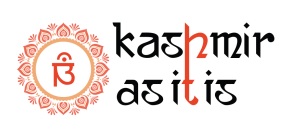Kashmiri Pandits both racially as well as ethinically are known to be the decendants of Kashyp Rishi. It is said that the Kashayp Rishi married the daughters of Daksh called Kadru and Vaneeta. While Kadru gave birth to one thousand powerful naags out of which Vaski Nag, Taksh Nag, Shaish Nag & Kali Nag stood tall, while as Vaneeta gave birth to Arun and Garuda. It is said that in his early age Garuda went to the Himalayas for meditation of Lord Vishnu. One day, both Vaneeta and Kadru were enjoying the sunrise and started discussing the color of the horses of the chariot of Sun God. Kadru said the color was black while Vaneeta was adament on white color. At last there was a bet in which the one who lost will serve other as a her servant. Kadru realised that she lost the bet and was worried that she will have to serve Vaneeta all her life. But her sons assured her that next sunrise they will wrap the horses and she will win the bet. Next morning both the sisters were eagerly waiting for the sunrise, since the horses were now clinged with the black naags, they appeared black and Vaneeta lost the bet and began serving Kadru. In the meantime Garuda came back from his meditation and told his mother that since Lord Vishnu was impressed with his devotion he has been offered to remain with Lord as his Vahan (carrier/ride). Vaneeta was happy for his son and also told him the whole tale of becoming a servant of her own sister. Garuda told Vaneeta that she had been cheated and thus revenge will be taken. On Naradji’s intervention, Garuda decided to go to the Lord Vishnu and ask for a solution. Lord Vishnu granted boon to him saying that the Naags will not have any effect on him and since then the Garuds & Naags became enemies. The serpants did serve the Garudas and in a hope of freeing themselves they started serving Narayana. The story goes on and it is said that the Nag futher remained in that area while as the Garuda flew to the east.
 Thus Kashmiri Pandits are believed to be the residents of Kashmir since the Pro-Regvedic era (1700-1100BC). History of the Kashmiri Pandits starts with the history of Kashmir valley which is more than 11000 years old. Thus the Pandits are responsible for society, culture, civilization, customs, traditions, myths and realities of Kashmir.
It is said that Kashmir was once filled with the river called Satisar or Saraswati river. Once the cleft at Baramulla appeared and hence the water of river was dried. Now the people living on the banks of the Saraswati river travelled to the Kashmir Valley to continue their austerities. With time they came to be known as Kashmiri Pandits of Kashmiri Battas. The valley of the Kashmir housed many Saints, Sages, Seers by which the community became a believer of Shaivism, Kali, Shakti and Trantra. It is also said by the experts that Kashmir has been the original home of the Aryan race. Kashmiri Pandits have been religiously rooted with Shaivism. It is said that in 400AD a school of Shiv Phylosophy called Pratyabhijna orignated nea Kailasha in Himalayas. This school adopts purely monistic and metaphysical position and is based on the phylosophy that Lord Maheshwara or Shiva is the supreme reality, which is innermost as well as Transcedent. And hence, Kashmir is called as the fountain-head of all the civilization and divine spirituality.
Thus Kashmiri Pandits are believed to be the residents of Kashmir since the Pro-Regvedic era (1700-1100BC). History of the Kashmiri Pandits starts with the history of Kashmir valley which is more than 11000 years old. Thus the Pandits are responsible for society, culture, civilization, customs, traditions, myths and realities of Kashmir.
It is said that Kashmir was once filled with the river called Satisar or Saraswati river. Once the cleft at Baramulla appeared and hence the water of river was dried. Now the people living on the banks of the Saraswati river travelled to the Kashmir Valley to continue their austerities. With time they came to be known as Kashmiri Pandits of Kashmiri Battas. The valley of the Kashmir housed many Saints, Sages, Seers by which the community became a believer of Shaivism, Kali, Shakti and Trantra. It is also said by the experts that Kashmir has been the original home of the Aryan race. Kashmiri Pandits have been religiously rooted with Shaivism. It is said that in 400AD a school of Shiv Phylosophy called Pratyabhijna orignated nea Kailasha in Himalayas. This school adopts purely monistic and metaphysical position and is based on the phylosophy that Lord Maheshwara or Shiva is the supreme reality, which is innermost as well as Transcedent. And hence, Kashmir is called as the fountain-head of all the civilization and divine spirituality.However its been not so long, just from the couple of mellinniums that the race was tried being dominated by other religions and castes. Initially it was Bhuddhism that flourished in North Kashmir housing over 500 monks to attend a Bhuddhist council in the valley during the reign of Durnadeo,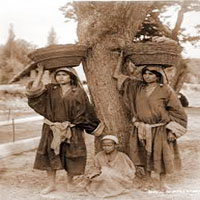 Simhadeo, Sundersen, Ashoka and Kanishka. It is also said that during the reign of Abhimanu in Kashmir the Pandits had to struggle for their survival as large number of their sect was forced to convert into Bhuddhism. History says that some of Kashmiri scholars – Kumarajiva (AD 384-417), Shakyashri Badhra (AD 405), Ratnavera, Shama Bhatta (5th Cen AD) and others went to China and Tibet to preach Buddhism. Then Pandits again gained power with the reign of Nara I which gave a rise to modern Hinduism giving an end to the Pandit- Bhuddhist struggle. However the actual comparative historical validity began with the establishment of the Karkuta rule in AD 627. After him, Avantivarman ruled Kashmir from 855-833AD. He is believed to be first Vaishnaviet rule of the valley and he bought a good cultural development in the valley. Again after couple of centuries, Kashmir struggle with the existence of Pandits against Kayasthas during the reign of Shankara varman. The authority of the Brahmans was broken and the sacred character of their citadels was violated. However, the Shaivite thoughts and philosophy still flourished.
Simhadeo, Sundersen, Ashoka and Kanishka. It is also said that during the reign of Abhimanu in Kashmir the Pandits had to struggle for their survival as large number of their sect was forced to convert into Bhuddhism. History says that some of Kashmiri scholars – Kumarajiva (AD 384-417), Shakyashri Badhra (AD 405), Ratnavera, Shama Bhatta (5th Cen AD) and others went to China and Tibet to preach Buddhism. Then Pandits again gained power with the reign of Nara I which gave a rise to modern Hinduism giving an end to the Pandit- Bhuddhist struggle. However the actual comparative historical validity began with the establishment of the Karkuta rule in AD 627. After him, Avantivarman ruled Kashmir from 855-833AD. He is believed to be first Vaishnaviet rule of the valley and he bought a good cultural development in the valley. Again after couple of centuries, Kashmir struggle with the existence of Pandits against Kayasthas during the reign of Shankara varman. The authority of the Brahmans was broken and the sacred character of their citadels was violated. However, the Shaivite thoughts and philosophy still flourished.
Then during the reign of Lohara dynasty, Kashmir came under the influence of Islam. When Mehmud Ghazni annexed Punjab, most of the Kashmiri Pandits converted into Islam for the sake of their lives. At that time, the Valley was ruled by Sangram Raja (AD 1003-1028). Even after their conversion to Islam, these people continued to visit Kashmir – as traders, wanderers and even missionaries. It is also said some of the converties stayed in the valley propogating their new religion. Similar things happened in the reign of Harsha (AD 1089-1101); Gopadeva (AD 1171-1180); Jassaka (AD 1180-1198) where the temple treasuries were depleted and Islam started to consolidate its roots. Roots of Pandits were shattered again and they were never allowed to monopolize.In the reign of Jassaka (AD 1180-1198), two Brahmans – Kshuksa and Bhima, endeavored to capture the throne. But it was the fear of Damaras or feudal lords that prevented them. Ramadeva (AD 1252-1273) humiliated those Brahmans who had helped him in his coronation. They conspired against him but could not succeed. A reign of terror, loot and plunder was let loose against them. Many Brahmans were killed and others crushed barbarously. This was the first direct assault against them in the history of Kashmir. To save themselves they cried “ Na Batoham” (I am not a Bhatta).
The Kashmiri Pandits are even now taunted as Bhattas and Dalli 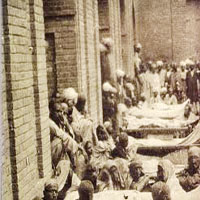 Bhattas. During the reign of Suhadeva (AD 1301-1320) many Muslim adventurers came to Kashmir. The chief among them was a Muslim missionary- Bulbul Shah. Dulucha, a Tartar chief from Central Asia, invaded Kashmir with 60,000 strong horsemen. Suhadeva tried to induce him to retreat by paying him off a large sum of money by imposing heavy taxes on Pandits who till then never lived by paying taxes. Dulucha denied the offer and continued the terror attacks. As mentioned in Baharistan – i -Shahi; Dulucha and his army men killed every men they found, women and children were made slaves and were sold to the merchants of Turkistan. Suhadev fled to Kishtawar and Dulucha looted kashmir for eight months. It is said that he took with him 500,000 pandits as slaves. There were only few cursed Pandit families left in the haunted valley blaming their ruler Suhadeva for the mishap. Taking the advantage of this, a pseudo- Buddhist from Tibet occupied the throne. Since he wanted to wanted to get initiated into the Brahmanical fold to strengthen his political position, he called religious head to indoctrinate himself into the Hindu religion. But the Pandits denied and refused to accept him as a Hindu because of his low birth. Pandits were not ready to share their “Panditsm” with any outsider. However taking advantage of this Shahmir and Bulbul Shah (missionaries from Islam) manipulated his conversion into Islam and thus the Muslim ruling in Kashmir came into existence. During his rule, people of poorer families and subdued casts were gradually converted into Islam.
Bhattas. During the reign of Suhadeva (AD 1301-1320) many Muslim adventurers came to Kashmir. The chief among them was a Muslim missionary- Bulbul Shah. Dulucha, a Tartar chief from Central Asia, invaded Kashmir with 60,000 strong horsemen. Suhadeva tried to induce him to retreat by paying him off a large sum of money by imposing heavy taxes on Pandits who till then never lived by paying taxes. Dulucha denied the offer and continued the terror attacks. As mentioned in Baharistan – i -Shahi; Dulucha and his army men killed every men they found, women and children were made slaves and were sold to the merchants of Turkistan. Suhadev fled to Kishtawar and Dulucha looted kashmir for eight months. It is said that he took with him 500,000 pandits as slaves. There were only few cursed Pandit families left in the haunted valley blaming their ruler Suhadeva for the mishap. Taking the advantage of this, a pseudo- Buddhist from Tibet occupied the throne. Since he wanted to wanted to get initiated into the Brahmanical fold to strengthen his political position, he called religious head to indoctrinate himself into the Hindu religion. But the Pandits denied and refused to accept him as a Hindu because of his low birth. Pandits were not ready to share their “Panditsm” with any outsider. However taking advantage of this Shahmir and Bulbul Shah (missionaries from Islam) manipulated his conversion into Islam and thus the Muslim ruling in Kashmir came into existence. During his rule, people of poorer families and subdued casts were gradually converted into Islam.
In AD 1339, Shahmir ascended the throne of Kashmir by a foul play. He got khutaba read and the coins struck to his name and hence Islam became the court religion of Kashmir. Thus he became the author as well as the architect of the valley. During his reign Muslim missionaries, preachers, sayyids and saints penetrated into the Valley. Gradually threat to the Pandit community due to the establishment of Islam and gradual conversion led to a frail rebellion during the reign of Shihab-ud-Din (AD 1354-1373). This annoyed the king so much so that the poor Pandits had to pay a huge amount. Pandit temples became a new target of the Muslim rulers. Many temples of historic importance including that of Brijbhihara were wrecked.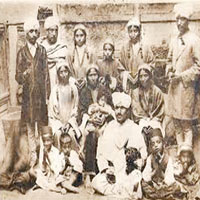 The Hindus began to feel deserted and alienated in their own land. To make their roots more stronger in the valley, Muslim rulers passed a law called the “policy of extermination” which meant to eradicate all traces of Hinduism in any form. During this period many Pandits stuck with their religion without fear however many of them also converted for the sake of their lives or to gain royal favors. The converted Pandits have been looked inferior, traitorous and treacherous, with no loyalty towards their community. The King was now not interested in his ministry affrairs rather he felt delighted in causing pain to Pandits. Its said he took delight in breaking the images of Martanda, Vishaya, Ishana, Chakrabrit and Tripureshvara.
The Hindus began to feel deserted and alienated in their own land. To make their roots more stronger in the valley, Muslim rulers passed a law called the “policy of extermination” which meant to eradicate all traces of Hinduism in any form. During this period many Pandits stuck with their religion without fear however many of them also converted for the sake of their lives or to gain royal favors. The converted Pandits have been looked inferior, traitorous and treacherous, with no loyalty towards their community. The King was now not interested in his ministry affrairs rather he felt delighted in causing pain to Pandits. Its said he took delight in breaking the images of Martanda, Vishaya, Ishana, Chakrabrit and Tripureshvara.
There was no city, no town, no village, no wood where Turushka left the temples of the gods unbroken.It is said that the valley was so enriched with the fine workmenship of the magnificant temple structures that the King Sikandar was biwildered after having a sight. Sikandar, goaded by feelings of bigotry, destroyed them and levelled them with the earth and with the material built many mosques and khanqahs.He started his regime of destroying the temples from Martand temple (Built by Ramdeva and then rebuilt by King Lalitaditya, AD 724-760). It is said that when the king failed to demolish the temple in one year, he dug out stones from its base and having stored enough wood in their place, set fire to it. The gold gilt paintings on its walls were totally destroyed and the walls surrounding its premises were demolished. Its ruins even now strike wonder in men’s minds. On the similar lines the Vijiveshwara temple, was damaged and material collected from this site was used to built the mosque at the Khanqah, which is now known as Vijiveshwara mosque. It was notified that the Pandits either need to convert to Islam or get killed. As a result some Pandits fled from the valley and few convereted and those who retaliated were brutally murdered.
It is said that Sikandar collected six maunds of sacred thread form Hindu converts and seven mauds of sacred thread from hindu killings and burnt them. All the hindu books were either buried or burnt. Ali Shah – (AD 1413-1430), son of Sikandar- the Butshikan, during his short rule of six years, carried on his father’s 24-year tyrant reign with homicides, conversions, tyranny and enforced jazia. Thus many of the Pandits either fled or killed themselves or died because of the brutality caused to them by Muslim Rulers. Through the centuries as men depart from this world, so did the Aryan Saraswat Brahmans of Kashmir flee to foreign countries. The difficult countries through which they passed, the scanty food, painful illness and the torments of hell during life time removed from the minds of the Kashmiri Pandits the fears of hell. Oppressed by various calamities such as encounter with the enemy, fear of snakes, fierce heat and scanty food; many Brahmans perished on the way and thus obtained salvation.” This was the second miserable mass exodus of the Kashmiri Pandits. Later Sultan Zainul Abidin-the Budshah (Great Monarch), ruled Kashmir from AD 1420 to 1460. This time is said to be the honeymoon period of Pandits which did not last long when Haider Shah (AD 1470-1472) took the throne. Again Haidar Shah adopted all the corrupt and cruel practises against the Pandits. The pressure exerted on the illustrious Kashmiri Pandits was so barbarous that, in order to save themselves from merciless brutality, some of them gave up their caste and some fled from the valley. The cruelities of the rulers continued in the reign of Fateh Shah (AD 1510-1517) and Pandits suffered ferociously, resulting in third exodus. Those who stayed behind were not only forced to pay jazia. History continued with Qazi Chak, the founder of Chak rule in Kashmir (AD 1553-1586), carried on ferocious religious policy and made conversion of many Hindus to Shia sect of Islam. However, he could not administer his criminal designs because of the Mughal annexation.
All the hindu books were either buried or burnt. Ali Shah – (AD 1413-1430), son of Sikandar- the Butshikan, during his short rule of six years, carried on his father’s 24-year tyrant reign with homicides, conversions, tyranny and enforced jazia. Thus many of the Pandits either fled or killed themselves or died because of the brutality caused to them by Muslim Rulers. Through the centuries as men depart from this world, so did the Aryan Saraswat Brahmans of Kashmir flee to foreign countries. The difficult countries through which they passed, the scanty food, painful illness and the torments of hell during life time removed from the minds of the Kashmiri Pandits the fears of hell. Oppressed by various calamities such as encounter with the enemy, fear of snakes, fierce heat and scanty food; many Brahmans perished on the way and thus obtained salvation.” This was the second miserable mass exodus of the Kashmiri Pandits. Later Sultan Zainul Abidin-the Budshah (Great Monarch), ruled Kashmir from AD 1420 to 1460. This time is said to be the honeymoon period of Pandits which did not last long when Haider Shah (AD 1470-1472) took the throne. Again Haidar Shah adopted all the corrupt and cruel practises against the Pandits. The pressure exerted on the illustrious Kashmiri Pandits was so barbarous that, in order to save themselves from merciless brutality, some of them gave up their caste and some fled from the valley. The cruelities of the rulers continued in the reign of Fateh Shah (AD 1510-1517) and Pandits suffered ferociously, resulting in third exodus. Those who stayed behind were not only forced to pay jazia. History continued with Qazi Chak, the founder of Chak rule in Kashmir (AD 1553-1586), carried on ferocious religious policy and made conversion of many Hindus to Shia sect of Islam. However, he could not administer his criminal designs because of the Mughal annexation.
Then came the rule of the Mughals. Akbar was said to be tremendously influenced by the amazing moral supremacy of the Kashmiri Pandits.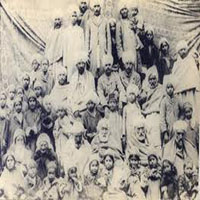 As recorded in Ain-i-Akbari, “the most respectable class in this country (Kashmir) is that of the Pandits, who, notwithstanding their need for freedom from the bonds of tradition and custom, are the true worshippers of God. They do not loosen their tongue of calumny against those not of their faith, nor beg, nor importune. They employ themselves in planting fruit trees and are generally a source of inspiration for others”. The greatness of Akbar lies in his magnificent and fascinating policy of religious tolerance. Jahangir and Shah Jahan were not so tolerant. But their religious enthusiasm cannot be termed as fanatic. During this period, the Brahmans could perform their religious ceremonies after paying some tribute. But the whole scenario changed with the accession of Aurangzeb to the throne. With his bigoted fanatic and dogmatic approach, the Kashmiri Pandits were once again made vulnerable. Aurengzeb terrorized Pandits and it was the fourth disastrous mass exodus of the Aryan Saraswat Brahmans from Kashmir. During the rule of later Mughals, Kashmir witnessed the outbreak of the worst kind of religious intolerance.In AD 1720, Mullah Abdul Nabi, also called Muhat Khan, a non-resident Kashmiri Muslim, was appointed as Shaikhul Islam . . In order to satisfy his satanic ego, the Mulla issued six commandments:
As recorded in Ain-i-Akbari, “the most respectable class in this country (Kashmir) is that of the Pandits, who, notwithstanding their need for freedom from the bonds of tradition and custom, are the true worshippers of God. They do not loosen their tongue of calumny against those not of their faith, nor beg, nor importune. They employ themselves in planting fruit trees and are generally a source of inspiration for others”. The greatness of Akbar lies in his magnificent and fascinating policy of religious tolerance. Jahangir and Shah Jahan were not so tolerant. But their religious enthusiasm cannot be termed as fanatic. During this period, the Brahmans could perform their religious ceremonies after paying some tribute. But the whole scenario changed with the accession of Aurangzeb to the throne. With his bigoted fanatic and dogmatic approach, the Kashmiri Pandits were once again made vulnerable. Aurengzeb terrorized Pandits and it was the fourth disastrous mass exodus of the Aryan Saraswat Brahmans from Kashmir. During the rule of later Mughals, Kashmir witnessed the outbreak of the worst kind of religious intolerance.In AD 1720, Mullah Abdul Nabi, also called Muhat Khan, a non-resident Kashmiri Muslim, was appointed as Shaikhul Islam . . In order to satisfy his satanic ego, the Mulla issued six commandments:
1.No Hindu should ride a horse, nor should a Hindu wear a shoe;
2.That they should not wear Jama (Mughal costume);
3.That they should move bare arms;
4.That they should not visit any garden;
5.That they should not have tilak mark on their foreheads;
6.That their children should not receive any education.
But the Deputy Governer disagreed, however the Mullah was able to excite his followers against Pandits and made sure that these commandments were follwed. The Pandits were wickedly tormented, their houses burnt and property looted. Hundreds of Brahmans were killed, prostrated, maimed and humiliated. Pandit parents destroyed the beauty of their daughters by shaving their heads or cutting their noses and ears to save them from degradation.
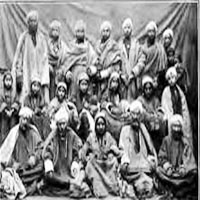
There was horrible mass exodus of the Kashmiri Pandits, sixth one. It is because of these tortures the Afghans are now only remembered for their barbarity, brutality, ferocity, tyranny and cruelty. It was then during the Sikh rule in Kashmir, AD 1819-1846, the celebrated Pandits reclaimed their past glory and magnificence. With the formation of Jammu and Kashmir State; and, establishment of the Dogra rule in 1846, Kashmiri Pandits were imperceptibly elbowed to the background.Administrators and officials were deputed from Jammu region. Though they enjoyed comprehensive religious freedom and social emancipation, political rights of the Kashmiri Pandits were confined. After independence and accession of Jammu & Kashmir state to India, Kashmiri Pandits were pushed back to the uncultured Afghan era. The administration of Shaikh Abdullah adopted malicious and pernicious approach towards the Saraswat Pandits of Kashmir. They were taunted on one excuse or the other. Hindu temples were desecrated, looted and plundered. Minor girls of the community were forced to embrace Islam and marry the Muslim youth.During 1953-1974 Shaikh Abdullah characterized India as an imperialist power endeavouring to subjugate the people of Kashmir. He asserted that the accession of Kashmir with India was his greatest blunder for which history will never forgive him. He also campaigned against the import of food grains from India and asked people to eat potatoes grown in Kashmir. Thus he was also known as “Aalo Bab”.
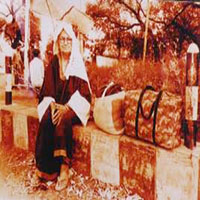
During his period of so called Sheikhdom, he was attrested many times, once in 1953 for anti-national activity however was relased in 1958. He was rearrested after 3 months of his release for “Kashmir conspiracy case” however the charges were dropped in 1964. But he was arrested again in May 1965 for his subversive activities and released in January 1968. Again, in January 1971, a ban was imposed forbidding him to enter the Jammu Kashmir state.This restriction was lifted in 1972. He made emotional solicitations that after death his body should not be buried in the subjugated Valley, but immersed into the sacred waters of Arabian sea. However, today his magnificent tomb stands on the banks of beautiful Dal Lake in Srinagar and is guarded by the Indian security personnel.But then the whole political scenario in Kashmir took a dramatic turn in 1974, when Indira-Shaikh accord was signed by virtue of which the Shaikh became the Chief Minister of the State after the lapse of 22 years.The sophist Shaikh began to speak the language of Indian nationalism, democracy, socialism and secularism. But hate India virus had already infected people of the state. And the History repeated itself with the mass exodus of Pandits in 1989-1990.
